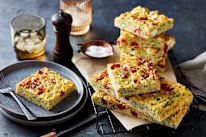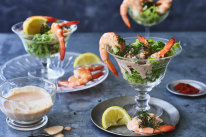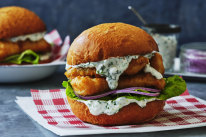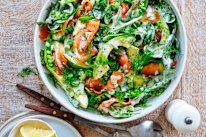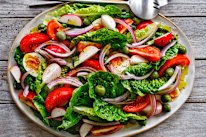The secret to Adam Liaw’s perfect French onion soup? You’ll just have to wait and see
It takes time to bring out the rich caramelised flavour in one of the world’s great dishes. So block out the next two hours and enjoy the process.
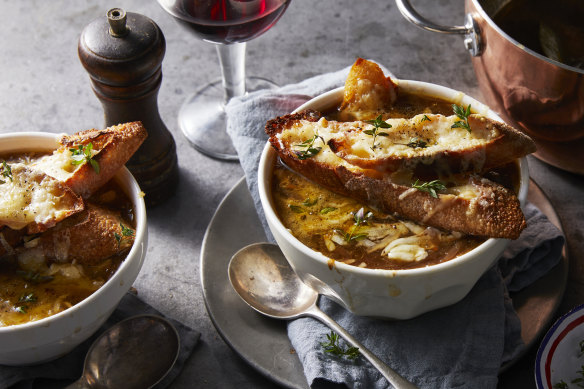
Paris 2024 is upon us, which seems a good time to dive deep off the 10-metre platform into one of the world’s most iconic dishes, which also happens to be one of the most misunderstood. If you thought French onion soup came in little packets (mainly used for mixing with sour cream to make dip), then strap in for a crash course on this gold medal-worthy dish.
Ingredients
100g butter, plus a little extra for the baguette
1kg brown onions, peeled and thinly sliced
salt and black pepper, to season
2 fresh bay leaves
6 sprigs fresh thyme, plus extra to serve
125ml (½ cup) white wine
3 tbsp sherry (or port)
2 litres good-quality beef stock
2 tsp powdered gelatine (optional)
12 thick slices of baguette
300g grated gruyere cheese, or another melting cheese
Method
Step 1
Heat a large, heavy saucepan over low-medium heat and add the butter, onions, salt and pepper. Cook slowly, stirring regularly, for about 45-60 minutes until the onions are well caramelised (see recipe notes).
Step 2
Add the bay leaves, thyme, white wine and port or sherry, then increase the heat and bring to a simmer. Simmer until the wine stops smelling alcoholic, then add the stock and gelatine. If you are using home-made stock, you can leave out the gelatine (see recipe notes). Reduce the heat and simmer, covered, for 20 minutes. Taste the soup and adjust the seasoning.
Step 3
Heat the oven to 160C fan-forced (180C conventional). While the soup is simmering, lightly butter the baguette slices, placing them on a rack over a baking tray. Toast until lightly browned, then remove from the oven and set aside.
Step 4
Fill ovenproof serving bowls with the soup, leaving a few centimetres clear at the top of each bowl. Add 2 slices of toasted baguette to each bowl, season with a little salt and cover with grated cheese. Place the bowls under the oven grill and grill until the cheese is browned and bubbling (see recipe notes). Serve scattered with a few extra thyme leaves.
Masterclass
Caramelising onions 101
If you see a recipe for French onion soup that tells you to caramelise onions in 20 minutes, close the tab and move on. You can get some nice fried onions in that time, but if you want to caramelise onions properly, you’ll need at least 45 minutes and maybe even an hour, depending on how far you take them.
While the process is time-consuming, it’s not particularly labour-intensive. Induction cooktops are ideal for this because they give an even, controllable heat across the base of the pot. On my induction cooktop, the setting I use for caramelised onions is the arbitrary number ‘5’ but once you work out the right number or burner setting in your kitchen, it’s the kind of thing you can set and forget.
I use a virtual assistant (“Hey Google”) to set a timer for 6 minutes, then walk away and go on with my day. When the timer goes, I come back and stir the pot with a wooden spoon, scraping up any fond (the brown residue that forms on the base). Then I reset the timer and go back to whatever I was doing. Repeat that 10 times and you have caramelised onions.
Should I make my own beef stock?
I make stock sometimes, and you should too. But I’m also a realist who understands that making stock from scratch every time isn’t entirely compatible with Australian life in the 21st century. If I had to guess, I’d say I make chicken stock about once every two weeks, dashi and other stocks about once a month and beef stock about once a year.
Making beef stock can be a bit of a process – buying bones, roasting them with vegetables, cooking them for a long time and putting up with the smell of boiling bones in the house for a couple of days. But it’s worth doing once in a while, and this soup is the kind of thing I would make with it. (The other thing I make with home-made beef stock is a demi-glace, which you can freeze and use year-round as an excellent sauce base for a good piece of steak.)
Luckily, home-made or shop-bought stock aren’t the only options. For dishes such as soup or risotto, where good-quality stock is important, you can use shop-bought stock as a starting point, then build on it. Great ways to improve a dull liquid commercial stock include simmering it with roasted vegetables (or in this case, onions roasted in halves with the skin on); adding extra herbs; or boosting the savouriness with a little soy sauce, fish sauce or even a bit of powdered stock.
When I’m making soups or sauces with commercial stocks, I like to add gelatine, which is often removed in the manufacturing process to prevent the stock from solidifying on the shelf or in the fridge. Gelatine is important for a dish like this – it gives the soup lip-smacking richness. Thankfully, you can buy packet stock anywhere you buy powdered gelatine.
No flour
Adding a few tablespoons of flour to the caramelised onions can give the soup more body, but I recommend against it. One of the things to appreciate about French onion soup is that it’s a light, almost consommé-like soup enriched by the onions, with toasted baguette providing extra texture. Thickening the soup with flour makes it heavier, and can make the end product taste like drinking a bowl of gravy.
Under the grill
The French name for this soup is “soupe à l’oignon gratinée” or onion soup gratin, so the gratineed cheese is an integral part of the finished product. It’s traditionally served in a pot-bellied, double-handled French cooking vessel called a marmite (pronounced marr-meet), which gave its name to the British sandwich spread Marmite (and in turn influenced the name of our own Vegemite).
Most crockery can happily go into the oven, even if it’s not specifically labelled “ovenproof”. Porcelain is fired at much higher temperatures than a domestic oven will reach, and if your bowls are filled with soup, they aren’t likely to crack as the heat density of the soup will stop the bowl from overheating. Grilling can be more aggressive, however, so if you don’t want to risk your regular bowls, either get some oven-safe marmites, use ramekins or cocottes (individual baking dishes), or simply grill the cheesy baguette slices separately and drop them onto the soup to serve.
The main problem with grilling at home is that most modern ovens only grill with the door closed, and even then, only to a particular temperature, so the heating element turns off once that temperature is reached. For that reason, I often grill when the oven is starting to warm up. The top element will stay on longer, ensuring a nice gratinated surface.
Appears in these collections
- The 50 most popular recipes of 2024 prove chicken dishes rule the roost
- Cheesy does it: The 30 most popular new recipes of winter 2024
- Five cheesy spins on French onion soup to make this weekend
- From ‘embarrassingly simple’ pasta to one-pot wonders: The 20 most popular recipes of July
- Pots of gold: 20 hot new soups (plus Adam Liaw’s garlic bread ideal for dunking)
The best recipes from Australia's leading chefs straight to your inbox.
Sign upFrom our partners
Similar Recipes
More by Adam Liaw
Original URL: https://www.theage.com.au/goodfood/recipes/the-secret-to-adam-liaw-s-french-onion-soup-patience-20240708-p5jrzs.html

